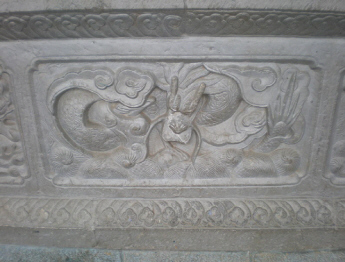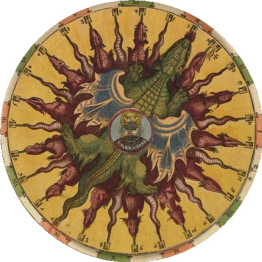POSSIBLE ASTRONOMICAL INDICATORS IN THE “BIOLOGICAL”
SECTION
This is a brief look at indications that
the “Biological” section of the Voynich Manuscript may contain astronomical
data, in relation to both Western and Chinese astronomy. I give some examples of
images of the astronomy of both cultures mixed into the images, in page order
rather than subject matter.
f75r
|

|
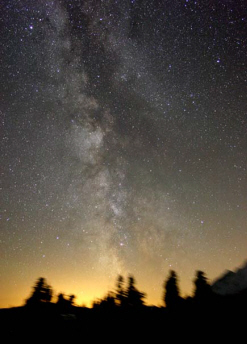 |
|
f75r,
Voynich Manuscript. Credit: Beinecke Rare Book and Manuscript
Library, Yale University. |
Milky Way.
Source Wikimedia Commons. Licence GFDL, CC Attribution-Share Alike 3.0.
Credit: IsabelleVP. |
I suggest that the rivers and pools with the nymphs in
are representative of the milky way or specific regions of the sky. In China and
other countries, the Milky Way was viewed as a celestial river that joined the
earth and sky, linking the world of the gods with the world of human. In ancient
China it was known as the “Tien Ho”, the “Silver or heavenly river”, the
celestial counterpart of the river Ho (the Yellow River) and it became swollen
in appearance during the rainy season like the river. This seems to fit the
imagery much better than the Greek myth that the Milky Way was caused by milk
spilt by Hera when suckling Hercules.
The nymphs in this setting would then be representative of heavenly bodies,
moving through space. The arrangement of the nymphs gives the feel that orbits,
planetary motion, retrograde motion and such like may be in the subject matter.
One of the nymphs appears to be holding a “gnomon” (shadow stick), the oldest
and most simple form of sundial. In China the Gui Biao, a combination of stick
(Biao) and ruler or dial aligned south-north (Gui) was used. It was a simple
pole about 8 feet long that was used to measure the sun’s shadow to calculate
the solstices and equinoxes, at night it was used to follow the passage of the
stars. In Greece the introduction of the gnomon was attributed to Anaximander
(born 7th century BC). Herodotos stated in his “Histories” (450 BC) that the use
of the gnomon was learnt of from the Babylonians and Mesopotamian texts talk of
the measurement of the shadow of a stick 1 cubit high in relation to time. It
was also used in Egypt, India and in Medieval Europe the sundial was used to
measure time much as the obelisks of the ancients had been. The gnomon was an
intricate part of astronomical instruments for many cultures and was used to
determine equinoxes and solstices, latitude and Eratosthenes even calculated the
size of the earth using two gnomen and camels. Thus the gnomen, a simple stick,
the oldest and simplest of astronomical instruments opened the door to
timekeeping and astronomy in many cultures and as such its appearance on the
first folio of this quire would not be out of place.
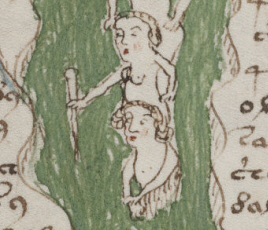 |
 |
|
f75r,
cropped. Voynich Manuscript. Credit:Beinecke Rare Book and Manuscript Library,
Yale University. |
Example of a shadow stick.
Tibetan Shepherd's tapering octagonal hard-wood Timestick. Licence GFDL.
Wikipedia. |
f75v
|
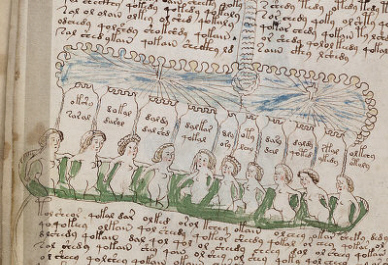 |
|
f75v,
cropped.
Voynich Manuscript. Credit:Beinecke Rare Book and Manuscript
Library, Yale University. |
This image looks
like it could represent a Mercator style projection of the sky or the world,
displaying both north and south poles. A twin hemisphere celestial or
terrestrial map, with a polar based centre representative of the Chinese
sky. Alternatively a diagrammatic representation of the idea of “Terra
Incognita” being a mirror image of the known world or sky. The wavy band
around the outside on the Voynich image may refer to the milky way if it is
a twin hemisphere celestial map.
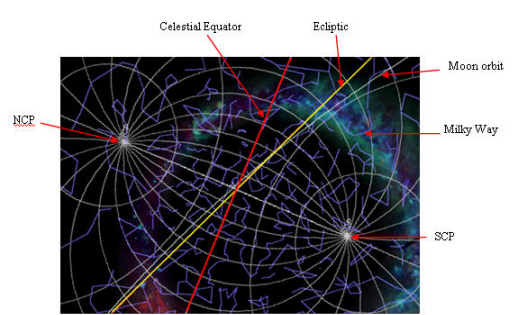 |
|
Credit: Redshift6.
Star map with overlay by P. Han showing sky map depicting
twin hemispheres.
|
A general
celestial map is shown above, showing both Polar regions (NCP left, SCP right),
constellations and the milky way (bright ring). The celestial equator
runs down middle top to bottom (bright gray line), the ecliptic (red
line). On the Voynich image there is a tube entering the “celestial map”
from the top mid section which could correspond to the equator,
ecliptic, or Moon's orbit among other things. Astronomy in China was
circumpolar and although the ecliptic, Huangdao” (yellow road) was
sometimes used in calculations, the Equator, “Chidao” (red road) was
central and was said to “encircle the heart of heaven”. The path of the
moon was called the “baidao” the white road. The names may be based on
coloured lines found on Han dynasty maps used to indicate these.
Some Southern
constellations were mentioned by Ptolomy in his 48 constellations, but
those around the Southern polar region (allowing for earth wobble) were
not added until much later. The earlier constellations mentioned only
represented those visible from 36 north of the equator, i.e. originated
in the Babylonian area. The first constellations were mentioned by Aratus in 270BC in Phaenomena, later Ptolemy in 128 AD wrote the
Almagest, the most famous of ancient star catalogues. It wasn’t until
explorers ventured south that further constellations were added. To aid
sea navigation “Crux”, the Southern Cross was made into a separate
constellation as there were no bright stars in the Southern polar region
and this constellation acted as a pointer instead, previously it had
been considered part of Centaurus by the Greeks and due to precession
was visible on their horizon, now it is not visible from northern
latitudes. As explorers ventured further into the southern hemisphere
more constellations were added, some of which have since been lost in
time and where gaps existed extremely low magnitude stars were brought
into play just to fill the sky maps with constellations such as Lynx
that were so dim they were said to require the “eyes of a Lynx” to make
them out at all.
f76r
Unlike
the other folios in this quire it is the only one without any images.
The subject matter can only be guessed from the other folios and any
clues that may lie in the glyphs text. Suggested subject matter –
“hidden eclipse”, “Venus revealed”, specifically related to the transit
of Venus, and other details on Venus.
f76v
|
 |
 |
| f76v cropped. Voynich Manuscript. Credit: Beinecke Rare Book and Manuscript Library,
Yale University. |
Credit: Redshift6.
Cepheus, Polaris the Celestial Zero
Meridian and the Galactic Equator. |
I suggest the figure in the top right of the folio is showing the
specific position of SN 1572 in relation to the North Celestial Pole,
the Celestial Zero Meridian and the Galactic Equator. The figure
representing Cepheus or the pole star, the round tube the North Pole and
the lines/dots emanating from the figure’s hands are the Celstial Zero
Meridian and the vertical markings that cross it at the edge of the page
the Galactic Equator. At the intersection point of these celestial
direction markers lay SN 1572.
|
 |
| f76v
cropped. Voynich Manuscript. Credit: Beinecke Rare Book and Manuscript Library,
Yale University. |
I suggest the image above
showing the figures on the left side of the foilo show
constellations locating SN 1572. From the top, Virgo, the North
Pole, Cassiopea and Andromeda at the bottom.
|
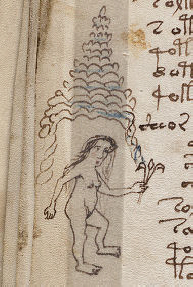 |
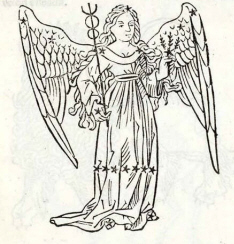 |
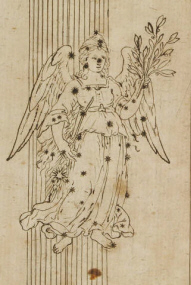 |
| F76v,
cropped. Voynich Manuscript.
Credit: Beinecke Rare Book and Manuscript Library, Yale
University. |
Mirror image. E 4 Verso.
Virgo woodcut. Hyginus, et al. 1482. Poeticon Astronomicon.
Credit: Linda Hall Library of Science, Engineering and
Technology |
Mirror image. Figure 20,
Virgo. Strauch, Aegidius. 1659. Astrognosia. Credit: Linda
Hall Library of Science, Engineering and Technology |
There are only three female
constellations of which two are shown holding spikes of grain or
flowers. Cassiopea is always seated leaving Virgo as the one
standing female constellation holding a spikes of grains. In star
maps she is mostly shown with wings but in calendars and zodiacs
often as a woman holding a flower. In Chinese astronomy Virgo is
part of the Azure Dragon of the East, and “Jiao Xiu 1” (Spica) is
the determining star of the first of the lunar mansions, “Jiao”
(Horn). The covering above the nymph in the Voynich Manuscript image
may represent a “lunar mansion”.
|
 |
| f76v
cropped. Voynich Manuscript. Credit: Beinecke Rare Book and Manuscript Library,
Yale University. |
The image above is unclear
but the item the nymph is holding may be a flower or it may represent a heart (with
trachea attached and lungs in red to the sides), the centre of
the sky being the North Pole in Chinese astronomy. A line can be
drawn from Virgo through the North Pole and on to SN 1572 in
Cassipoea in a Chinese style star map that centres around the
North Pole.
|
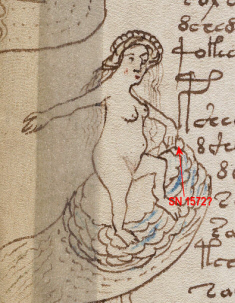 |
|
f76v cropped. Voynich Manuscript. Credit: Beinecke Rare Book and Manuscript Library,
Yale University. Overlay by P. Han showing suggested position of
SN 1572. |
The image above may be
Cassiopea, shown half sitting with what looks like a disc in her
left hand representing SN 1572.
|
 |
 |
|
Credit: Redshift6.
Star map showing constellations of Virgo, Cepheus,
Cassiopeia and Andromeda.Overlay by P. Han showing
position of SN 1572. |
Credit: Redshift6.
North Pole centred star map showing constellations of
Virgo, Cepheus, Cassiopeia and Andromeda. Overlay by P.
Han showing position of SN 1572 in relation to the
Celestial
Zero Meridian and
Galactic Equator. |
The images above show the
suggested constellations on f76v as shown on a Chinese style
North Pole centred star map. Cepheus is on the pole marking the
Celestial Zero Meridian and Galactic Equator. Virgo, the North
Pole, Cassiopeia and Andromeda all lie on the Celestial Zero
Meridian.
f77v
|
 |
| f77v, cropped. Voynich Manuscript.
Credit: Beinecke Rare Book and Manuscript Library, Yale University. |
Possibly Cassipoea. This constellation has always been
represented as the seated queen on her throne in Western astronomy. In Chinese
astronomy the area of Cassiopea was represented as a porchway and later a
charioteer, clearly if this is Cassiopea it is the Western interpretation.
Link to the Kugel Globe (top left globe), a " SILVER
CELESTIAL GLOBE FROM ANTIQUITY" in the Gallerie Kugel, Paris. Cassiopeia
can be seen hanging upside down at the bottom of the globe, seated and with arms
outstretched:
http://www.galeriekugel.com/expo_spheres/c/c_en.htm
Link to image of Cassiopeia on the Farnese Globe:
http://www.dioi.org/images/cad.jpg
The images on this folio have been compared to human
reproductive organs and in further reference to the discussion of the elements
on f77r this seems likely. Cassiopeia is the place of generation in the
universe, from her womb comes forth a new star, never before seen.
f78r
A real oddity on f78r, a ring with wavy
lines . The nearest astronomical possibilities to this may be the constellations
Coma or Corona, which have at various times been illustrated with a ring like
appearance. Corona is sometimes illustrated as a wreath with ribbons hanging
down and Coma as a circlet with hair hanging down. It may alternatively be
an unfinished pipe.
|
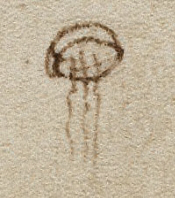 |
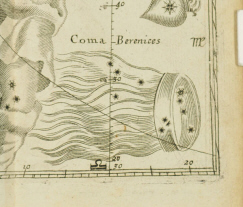 |
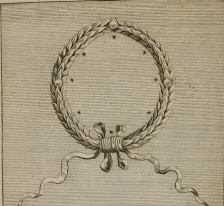 |
|
f78r, cropped. Voynich Manuscript. Credit: Beinecke
Rare Book and Manuscript Library, Yale University. |
Coma. Seller, John. 1700. Atlas Caelestis.
Credit: Linda Hall Library of Science, Engineering and Technology. |
Corona. Munckerus. 1681. Mythographi
latini. Credit: Linda Hall Library of Science, Engineering and
Technology. |
Coma Berenices is the constellation
containing the point of the Galactic North Pole. On the Chinese style Polaris
centred star map, SN 1572 and Coma are at opposite points of the Celestial North
Pole. Corona has no obvious relevance to the subjects.
|
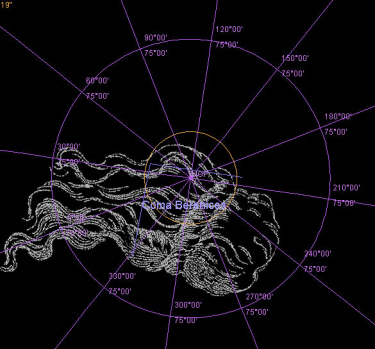 |
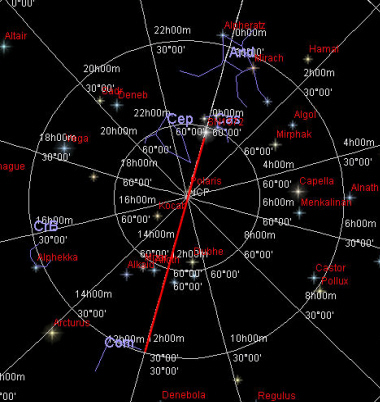 |
|
Credit: Redshift6. Coma at the North Galactic Pole. |
Credit: Redshift6
Chinese star map style view, Centred
around Polaris and the North Celestial Pole. Coma and SN 1572 are on
opposite sides of the pole. |
f78v
|
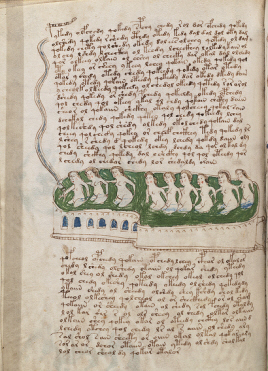 |
| f78v, Voynich Manuscript. Credit:
Beinecke Rare Book and Manuscript Library, Yale University. |
Suggest subject matter may be the
moon and its phases.
f79v
|
 |
| f79v, cropped. Voynich Manuscript.
Credit:Beinecke Rare Book and Manuscript Library, Yale University.
|
I suggest these images show
astronomical instruments, the cross staff and astronomer’s ring and the canopy
over the top nymph represents the area around the North Pole locating the
subject matter of this folio in that area. The bottom nymph holds what I
suggest is an astronomers ring or sundial and may represent the sun reclined,
i.e., night or setting, rather than deceased as the nymph is not wrapped in a
shroud. “The term astronomer's ring refers
mostly to a portable equatorial instrument having hinged meridian, equinoctial
and declination circles, described by Rainer Gemma Frisius (1508-1555). It can
be used as a "universal sundial.”
|

|
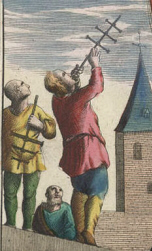 |
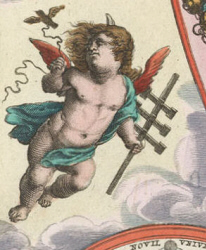 |
|
A Jacob's
staff, from John Sellers' Practical Navigation (1672). Source
Wikimedia Commons. PD image. |
Andreas Cellarius, Harmonia Macrocosmica, 1661. Second plate, cropped. Source Wikimedia
Commons. PD image. |
Andreas Cellarius, Harmonia Macrocosmica, 1661. Nineteenth plate,
cropped. Source Wikimedia Commons. PD image. |
The Jacobs staff was used by
astronomers to measure the angle between far away points to calculate latitude.
It was also used for surveying and example of this is shown on this link:
http://www.math.uni-hamburg.de/spag/ign/xyz/apianmes.gif
The image on the link below shows the astronomers rings being adapted to calculate altitude
for the purpose of surveying:
http://www.mhs.ox.ac.uk/measurer/images/fig45l.gif
Over time it became more complex suggesting the Voynich Manuscript illustration to be of an early type.
Link to examples of Ring Dials:
http://www.math.uni-hamburg.de/spag/ign/xyz/ringuhr.jpg
Link to example of construction of
Ring Dials:
http://www.math.uni-hamburg.de/spag/ign/xyz/ringuhrc.gif
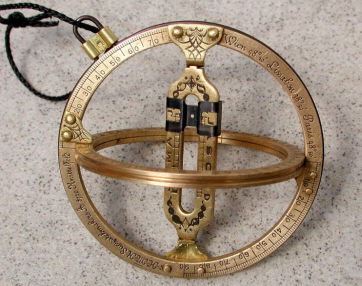 |
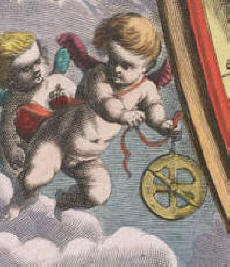 |
|
|
Ring sundial, opened in full view.
Source Wikimedia Commons. Copyright CC Attribution ShareAlike 2.0
Germany. Credit: Jailbird. |
Andreas Cellarius, Harmonia Macrocosmica, 1661. Twelth plate, cropped.
Source Wikimedia Commons. PD image. |
|
Link to example of Annular sundials,
high-altitude and equatorial:
http://www.math.uni-hamburg.de/spag/ign/xyz/ringuhr.jpg
The nymph below
the ones shown above appears ordinary apart from an odd looking stomach, which
appears rounded but also flat and collapsed as if having recently given birth.
A reference to the birth of a new star?
|
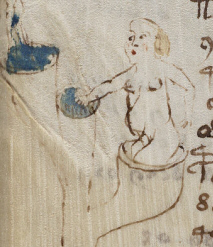 |
| f79v, cropped. Voynich Manuscript.
Credit:Beinecke Rare Book and Manuscript Library, Yale University.
|
|
 |
| f79v, cropped. Voynich Manuscript.
Credit: Beinecke Rare
Book and Manuscript Library, Yale University. |
I suggest this
this part of f97v shows constellations, including some that were not in existence before the
end of the 17th century. If this is the case then it puts the dating of the Voynich Manuscript of late 16th – early 17th century into question, and the
letter that accompanies the manuscript indicating it belonged to Rudolph II of
Bohemia (1552 – 1612) could not be factual unless the Voynich Manuscript was
written in sections over centuries and the letter specifically refers to the
earlier parts.
|
 |
| f79v,
cropped. Voynich Manuscript.
Credit: Beinecke Rare
Book and Manuscript Library, Yale University. |
Andromeda is changed out of expected orientation and looking upwards, suggesting
this is a marker. Possibly, she is indicated looking towards SN 1054, which
would be in the constellation Taurus above.
This is the part of the sky I suggest the image on f79v refers to:
|
 |
|
Credit: Redshift6.
Constellations Pisces, Andromeda, Lynx, Leo and Canes Venatici. |
The group on the left I suggest consists of Andromeda, one of the fish of Pisces
that touches Andromeda and Lacerta. The group on the right I suggest consists of
Leo Lynx and Canes Venatici (hunting dog). Again the image appears to be somewhat “coded”, Lacerta is straightforwardly a lizard, the nymph and fish also self explanatory. Of the figures on the right it is easier to examine them individually.
|
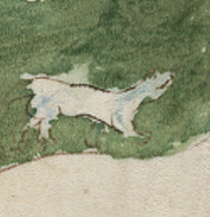 |
 |
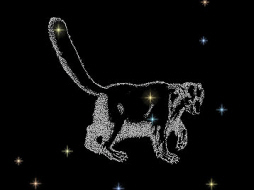 |
|
f79v, cropped. Voynich Manuscript.
Credit: Beinecke Rare
Book and Manuscript Library, Yale University. |
Credit: Redshift6.
Constellation Cannes
Venatici. |
Credit: Redshift6.
Constellation Ursa Minor. |
In
the Voynich Manuscript image there is only one creature shown, it has a long tail although this is
obscured by the paint. Although on first glance it looks
like another lizard the stance is close to that of the “hunting dog”,
alternatively it could refer to Ursa Minor, the baby bear of the sky with an
oddly long tail said to be due to be spun around the pole by its tail. In
an ancient alternative relating to the two bears of the sky to the myth of
Callisto and Arcas, Arcas is replaced by Bootes and Ursa Minor becomes a dog
complete with long tail. An ancient and no longer used name for Polaris is Cynosura which means dog' tail. Altough Ursa Minor is an ancient
constellation it's importance in representing the pole star is critical to the
concept of North Pole based Chinese astronomy.
Either way Canes Veatici and Ursa Minor both fit into this part of the sky.
The image below shows the constellations proposed but with Ursa Minor replacing
Canes Venatici, their bright star in the centre of both star maps is SN 1572.
|
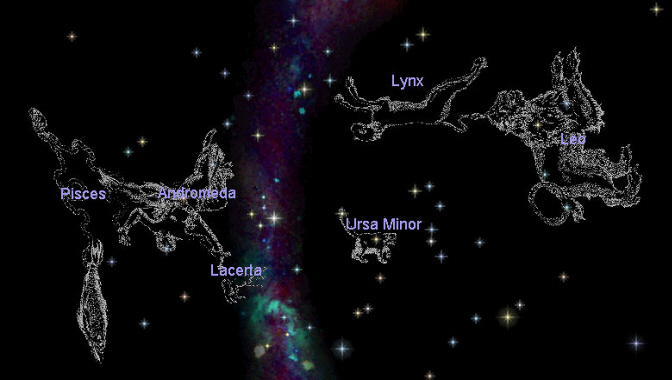 |
| Credit: Redshift6.
Constellations Pisces, Andromeda, Lynx, Leo and Ursa Minor. |
|
 |
 |
| f79v, cropped. Voynich Manuscript.
Credit: Beinecke Rare
Book and Manuscript Library, Yale University. |
Credit: Redshift6.
Constellation Leo. |
The image I refer to as Leo once again looks more like a lizard than a lion at
first glance. It again has a similar stance to Leo (mirror image Leo) and if the
head (which may just be badly drawn) is ignored the body has a feline
appearance. Compare the body alone to the Lion on the Leo zodiac page of the Voynich Manuscript.
|
 |
Leo. f72r, Voynich Manuscript.
Credit: Beinecke Rare
Book and Manuscript Library, Yale University. |
|
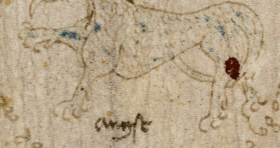 |
 |
|
Leo, f72r. Voynich Manuscript. Credit: Beinecke
Rare Book and Manuscript Library, Yale University. |
f79v, Voynich Manuscript. Credit: Beinecke Rare Book and Manuscript Library,
Yale University. |
The image
I refer to as Leo once again looks more like a lizard than a lion at first
glance. It again has a similar stance to Leo (mirror image Leo) and if the head
(which may just be badly drawn) is ignored the body has a feline appearance.
Compare the body alone to the Lion on the Leo zodiac page of the Voynich
Manuscript.
 |
 |
|
F79v,
Voynich Manuscript. Credit: Beinecke Rare Book and Manuscript Library,
Yale University. |
Lynx constellation.
Image from Firmamentum Sobiescianum by Hevelius, Johannes. Credit:
Linda Hall Library of Science, Engineering and Technology. |
The Voynich image shares the rounded ears of the Lynx constellation although it
appears to be limp and covered in blood as if killed, maybe by the dog or lion.
The subject of interest in relation to these constellations may be position of
the celestial pole or SN 1572. Andromeda, Pisces and Leo are ancient
constellations but the others are newer. Johannes Hevelius added Lacerta in 1687
to the sky map. Canes Venatici, the dogs had been previously a vague part of the
constellation of Bootes. On a star chart published in 1533 the German astronomer
Peter Apian showed Boötes with two dogs at his heels and holding their leash in
his right hand. Originally in Ptolomy’s Almagest the area of the Hunting dog was
Bootes club, but due to a mistranslation of the Greek word “Κολλοροβος “ it was
rendered Kullab (hook or crook) in Arabic and later on translation to Latin
Kullab was tranlated as Kilab (dog). Hevelius decided to make the dogs an
official constellation in their own right. He added the Lynx (originally “Lynx, sive Tigris”) to fill a gap and it was named the Lynx as one needed “eyes like a
Lynx” to make out the faint stars. Hevellius’ Lynx however, does not look very
Lynx like either. Hevelius introduced 11 new constellation In total in
“Firmamentum” (published posthumously 1690) but only 7 remain intact today.
They
are: Scutum Sobiescanum, Canes Venatici, Leo minor, Lynx, Sextans, Lacerta, and
Vulpecula cum Anser.
These constellations when present provide an earliest date for the work they are
found in of late 17th century, and along with this date the matter of whether
optics in the form of telescopes and microscopes COULD appear in work of this
date becomes a non-question.
Summary of the positions of the suggested constellations, the North celestial
pole, SN 1054 and SN 1572.
|
 |
|
Credit:Redshift 6. Constellations suggested to
be shown at the bottom of f79v, SN 1054, SN 1572 and the NCP. |
The fact that these suggested constellations are grouped around the celestial
pole is consistent with the Chinese view of the sky. Andromeda is orientated to
look up at Taurus, is consistent with the data being in reference to the
astronomical event of SN 1054 being compared and contrasted with the later SN
1572 in Cassipoea, although neither are directly illustrated on f79v.
Here is the overall interpretation of the image in relation to a North Pole
based Chinese star map and in consideration of the eyes being used as markers. A
rotated Andromeda looks up at SN 1054, Lynx looks down along the local Celestial
Meridian to Polaris, a rotated Leo looks at Ursa Minor and Lacerta and through
Polaris, Lacerta looks up at SN 1572 and towards Capella. Ursa Minor looks at
Regulus or the Plough, maybe one of the stars of the Plough in relation to the
Celestial Zero Meridian and thus Polaris and SN 1572. In China the Plough
was "Beidou" (Northern Dipper or ladle) or "Ye Yu", (the Chariot of the Emperor),
interestingly the plough also represented the government in ancient China. This
picture centres around the Pole star and relates the positions of SN 1572 and
1054 in terms of these constellations.
|
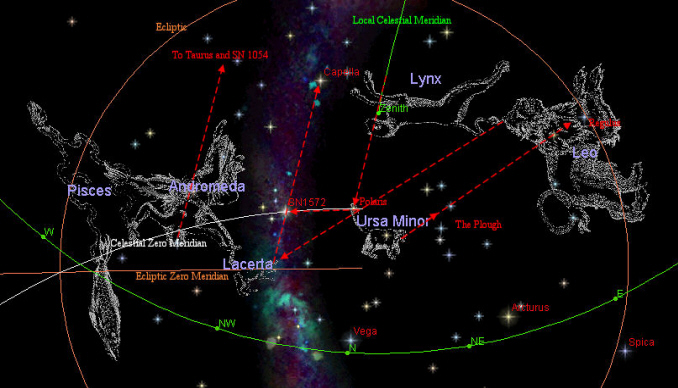 |
|
Credit: Redshift 6. Overlay by P. Han showing f79v in relation
to a North Pole based Chinese star map and in consideration of the
eyes being used as markers. |
And finally how this could relate to the Voynich Manuscript image on f79v below.
Polaris and the Celestial Zero Meridian are moved into the correct position by
the bear/dog raising its tail and dropping down as seen in the star atlases. Leo, and Andromeda are rotated in the star atlases and Lynx rotated and moved to
match the new position of Polaris and the Local Celestial Meridian. Andromeda is
leaning back and looking up but the line stokes of the eyes are complex appearing to indicate three directions, towards SN 1054, SN
1572 and North. SN 1572 in this scenario would be hidden by the tail of
the fish. The nymph directly above the nymph being swallowed by the
fish with the odd looking stomach may be Cassiopeia. If Andromeda is
put into her correct orientation she is looking directly at Cassiopeia (with a
swollen stomach about to give birth or having just given birth to the new star, SN 1572?).
|
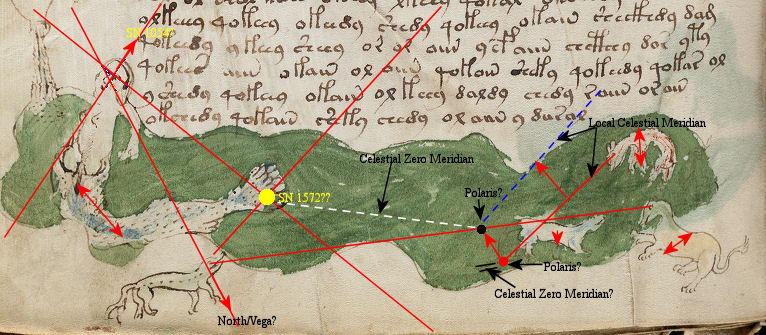 |
| f80r, cropped. Voynich
Manuscript. Credit:Beinecke Rare Book and Manuscript Library, Yale
University. Overlay by P. Han relalting the markers on the image to
the sky map |
f80r
|
 |
| f80r, cropped. Voynich
Manuscript. Credit:Beinecke Rare Book and Manuscript Library, Yale
University. |
This line up of nymphs
may show planets and stars and specifically a picture of the
ecliptic at a particular moment in time, but it appears to possibly portray some of
the discoveries of the 17th century. Suggestions are given for
the nymphs identities from right to left.
1
and 2:
The two figures on the far right I
suggest shows the Sun being pursued by the Moon or a male planet
(Mars/Saturn/Jupiter/Mercury). Unlike more
traditional images this may portray a female Sun and male Moon as also suggested
in the zodiac folio (a male Sun and female
Moon though most common is not universal). The female nymph is laden down with Sun
symbolism, she has the symbol of the Sun on her headdress, she is holding an
astronomers ring and has her arms crossed with the astronomers ring in a figure
8, the analemma, the shape which the sun forms in the sky over a year when
observed at the same civil time each day. She is being pursued by the male nymph
but unlike the image in the “Gemini” folio of the zodiac section their arms are
not linked, suggesting it is not an actual eclipse. In terms of 17th century
discoveries it could alternatively symbolise the calculation of the Earth-Sun
distance made by Cassini in 1672 by parallax measurements of Mars.
3:
A
star, or planet (Venus or Mercury) in normal motion.
4:
The nymph wearing a red stripped shawl, an image which is unique from the other
clothing they are shown wearing may represent an obviously red star such as Aldebaran or possibly the rings of Saturn. The rings were first discovered by
Galileo in 1610 AD but due to the low resolution of the telescope he first
thought they were satellites. They disappeared then reappeared and were
difficult to explain until Huygen in
1655 with the aid of a more powerful telescope observed they were solid, thin
flat ring, inclined to the ecliptic. The ring and its motion explained Galileo’s
observation of disappearing satellites.
5:
Planet shown in retrograde motion. As in the zodiac identification based on a
female nymph standing in water container this would be Venus. The
container in this instance is marked with a number of lines which I suggest show
the discovery of the phases of Venus like the Moon by Galileo in 1610 AD. This
was literally an “earth shattering discovery” as the Ptolemaic system could only
support only crescent and new phases, the heliocentric model was required to
explain the full range of phases seen by Galileo, it was proof that the
heliocentric model was correct.
6:
Star, or planet showing normal motion.
7:
Star or the Moons of Jupiter. The headdress of the nymph possibly
displaying the four Moons discovered by Galileo in 1610 AD. Although Jupiter is
a male planet its Moon may be represented as female.
8:
Star, or planet showing normal motion.
9:
Possibly the Sun. The nymph is shown holding a circle attached to a gnomon,
representing a sundial or spinning top indicating the rotation of the sun about
its axis as concluded by Galileo’s and Thomas Harriot's observation of Sunspots
in 1610.
10:
This nymph has to be a planet as shown in retrograde motion, as female it can
only be Mercury (in its female form) or Venus. Shown next to what may be
the Sun the headdress may represent the transits of the interior planets Venus
and/or Mercury. A transit of Venus was predicted by Kepler to occur in
1631 but was not visible in Europe, the first recorded observation was made in
1639 by Jeremiah Horrocks. The transit of Mercury was first observed and
recorded by Pierre Gassend in 1631.
The 17th century was a renaissance in astronomy powered by the newly invented
telescope. For example, In ancient Greece, Anaxagoras and Democritus had
proposed the Milky Way might consist of distant stars it was generally though to
be nebulous material in the upper atmosphere. Arabic astronomers had also
proposed that it consisted of a multitude of stars but proof did not come until
Galileo turned his telescope to the Milky Way in 1610 and saw it was made of
innumerable stars in clusters. He proposed that stars were suns, those nearer to
earth appearing brighter and those more distant appearing dimmer. This
interpretation by Galileo was even more “earth shattering” than evidence for the
heliocentric universe as it went a step further, if the stars were suns then our
Sun was just another star in an infinite sea of stars and stars. The
heavens were not immutable and at a time when Tycho, Kepler
and Galileo were getting to grips with a heliocentric universe, changeable and
imperfect (for death and decay speak of imperfection) this evidence was found 500 years earlier and may be the reason for SN1054 and SN1572
(and SN 1604) to be studied
side by side. The geocentric universe, the celestial spheres and the unchanging,
perfect heavens lay shattered, this was indeed dangerous times for astronomers
as they questioned the traditional teaching of the church and tore down the
unquestionable interpretation of doctrine, and with it the possibility of
destabilizing the power of the church. In the explanation of the nymphs at the
top of f80r may record the work
of Galileo and others from around 1610 to the
discovery of the actual rings of Saturn Huygen in 1655. This would give an earliest date for the manuscript to 1655 if they are the
“rings” of Saturn or 1610 if the nymphs only record Galileo’s
observations.
This however is just my interpretation of one image on one folio, but if a
single image were proven to contain such a vast amount of information then the
manuscript in its entirety could be an encyclopaedia of the most important
information of its time. The sort of information that was held to be heretical
or just plain wrong, not just by the church but other scientists of the time
also, astronomers and other died to uphold these new theories and in no
uncertain terms such material would have been worth protecting in a book of
code.
http://adsabs.harvard.edu/full/1894Obs....17..335L
|
Sun and Moon? |
|
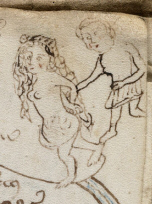 |
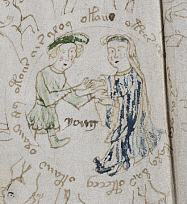 |
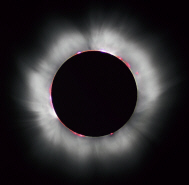 |
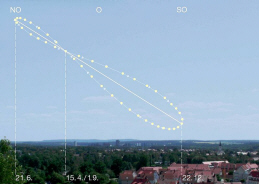 |
|
f80r, cropped. Voynich Manuscript.
Credit:Beinecke Rare Book and Manuscript Library, Yale University. |
f71v, cropped. Voynich Manuscript. Credit:Beinecke Rare
Book and Manuscript Library, Yale University. |
Solar eclipse 1999 Luc
Viatour. Credit:
©
Luc Viatour GFDL/CC. |
Fictional Photomontage illustrating an analemma pattern in the sky.
Source Wikimedia. Licence CC Attribution-Share Alike 2.0 Germany.
Credit: Jailbird. |
I
suggest the man and woman represent the sun and moon (or planet) and an eclipse when there
hands are joined, their hands crossed over showing the “figure 8” path of the
sun in the sky over the year. They appear to gain clothing as the eclipse
approaches and are shown fully clothed during the eclipse. It is interesting
that the male is pursuing the female, and the female is shown with crossed arms,
this suggests that the female is the Sun and if the male is the moon then this is
not the usual expected
interpretation of a male sun and female moon. This interpretation of switched
gender would mean that some of the other many female nymph images here and in
the zodiac section may represent the sun
also. The nymph wears a garland with a circle with a dot in the middle, this is
an ancient solar symbol, the nymph below her has the same symbols and may also
be the sun, some of the the other nymphs have garlands with various circles
also, but not with dots in them.

Solar
symbol.
Wikipedia. PD image.
The headdress of
the nymph on the far right looks almost like a sun next to a solar eclipse,
possibly a reference to SN 1054 and the nymph may be the constellation Taurus. Another nymph is pointing to the
stomach of this nymph which may represent the birth of SN 1054 at this point in
time.
|
Nymphs
with solar symbols? |
|
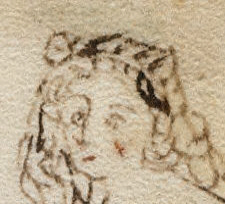 |
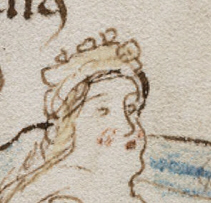 |
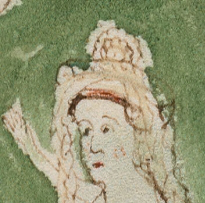 |
|
Nymph on far right. f80r,
cropped. Voynich Manuscript. Credit:Beinecke Rare Book and Manuscript
Library, Yale University. |
Nymph second from
right, middle. f80r, cropped. Voynich Manuscript. Credit:Beinecke Rare
Book and Manuscript Library, Yale University. |
f82r, cropped. Voynich
Manuscript. Credit:Beinecke Rare Book and Manuscript Library, Yale
University. |
|
Venus? |
|
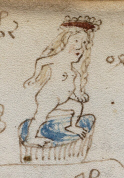 |
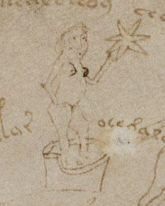 |
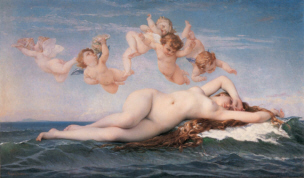 |
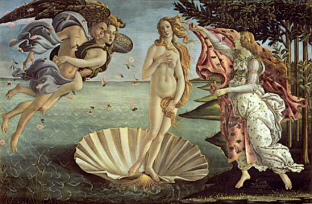 |
|
f80r,
cropped. Voynich Manuscript. Credit:Beinecke Rare Book and Manuscript Library,
Yale University. |
f72r,
cropped. Voynich Manuscript. Credit:Beinecke Rare Book and Manuscript Library,
Yale University. |
Alexandre
Cabanel, The Birth of Venus (1863).
Source Wikimedia Commons.
PD image. |
The Birth of
Venus (Botticelli).
Source Wikimedia Commons.
PD image. |
Bright Venus looks white to the naked eye but if often associated with water as
in the myth of the “birth of Venus”, where she is born out of the waves of the
sea. The “bucket” she is standing in, in the Voynich Manuscript, may represent
water, the sea or a shell.
|
Saturn? |
|
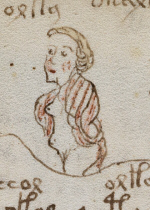 |
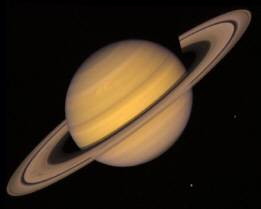 |
|
f80r, cropped. Voynich Manuscript. Credit:Beinecke Rare Book and Manuscript
Library, Yale University. |
Saturn. Credit: NASA. |
The nymph with the red stripped cloak may represent a red star like Aldebaran or
may represent the rings of a planet like Saturn. The rings of Saturn were
first discovered by Galileo in 1610 AD but due to the low resolution of the
telescope he first thought they were satellites. They disappeared then
reappeared and were difficult to explain until Huygen in
1655 with the aid of a more powerful telescope observed they were solid, thin
flat ring, inclined to the ecliptic. The ring and its motion explained Galileo’s
observation of disappearing satellites.
|
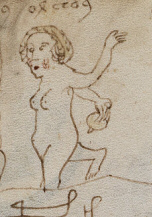 |
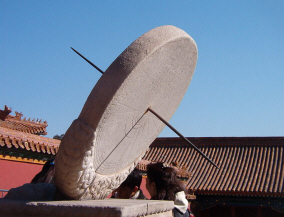 |
|
f80r,
cropped. Voynich Manuscript. Credit:Beinecke Rare Book and Manuscript
Library, Yale University. |
Source Wikimedia Commons.
Licence GFDL/CC 3.0.
Sputnikcccp. |
The second nymph from the left appears to be holding a sundial device, in
Chinese “rigui”, with a needle like“gnomon”. There are ancient examples of such
sundials in China. In a different interpretation
(as discussed in the “biological” folios section) as a spinning top it could
show the discovery that the sun spins on its axis (rotational
period of the Sun is roughly 25 days) as
demonstrated by Galileo in the early 1600s, rather than the sun being stationary
as was standard teaching for the time.
|
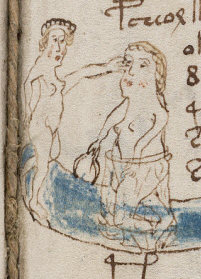 |
|
f80r,
cropped. Voynich Manuscript. Credit:Beinecke Rare Book and
Manuscript Library, Yale University. |
Nymph holding a pair of dividers used
for measurement, as seen in many star atlases and in portraits of astronmers.
The other nymph may be figuratively opening the eyes of the nymph holding the
dividers to new knowledge and understanding. This could indicate the invention
of the telescope that allowed for more accurate observation of the heavens and
the nymph could represent the earth and human knowledge.
|
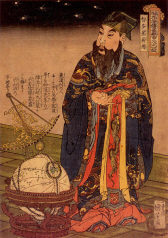 |
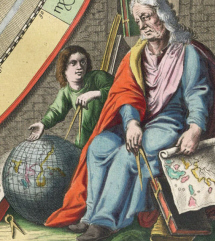 |
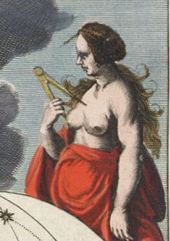 |
|
Chinese astronomer 1675.
Source Wikimedia Commons.
PD image. |
Andreas Cellarius, Harmonia Macrocosmica,
1661. First plate cropped. Source Wikimedia Commons. PD image. |
Andreas Cellarius, Harmonia Macrocosmica, 1661.
Thirteenth plate, cropped. Source Wikimedia
Commons. PD image. |
f80v
|
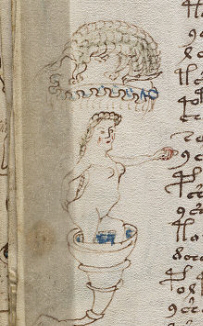 |
| f80v, cropped. Voynich Manuscript. Credit:Beinecke Rare Book and Manuscript
Library, Yale University. |
I
propose the sleeping animal is a dragon and the woman under it is holding an
“Astronomer’s Ring”. The dragon has long association with all things
astronomical, particularly in Chinese astronomy where it represents the area of
the Eastern sky as the “Azure Dragon”, and a dragon was thought to devour the
sun during solar eclipses. In Western astronomy it is associated with the
constellation Draco.
The “dragon” is shown curled up in a sleeping type position suggesting lack of
movement as would be displayed by a circumpolar constellation such as Draco. The
constellation Draco appears to wrap around the North Pole and circles Polaris,
the current polar star. In the past due to precession, the star Thuban in Draco
was once the pole star, until around 1,900 BC when Kokab began to move nearer to
the pole.
|
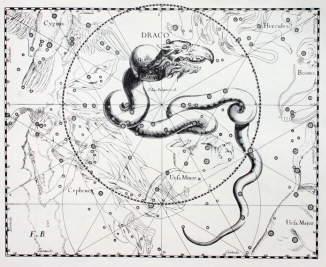 |
| Constellation
Draco. Joannes Hevelius Uranographia, Danzica 1690. Source Wikimedia
Commons. PD image. |
|
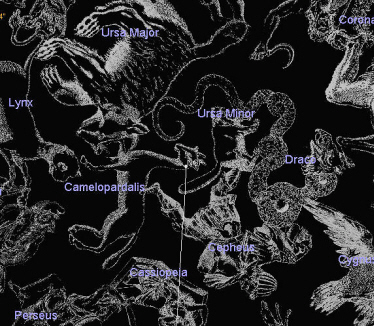 |
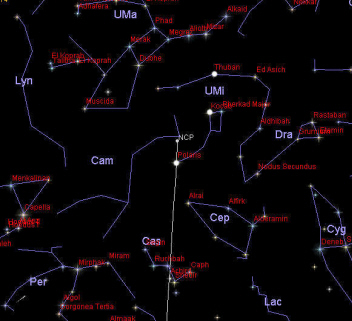 |
|
Credit: Redshift6
Position of Draco and
other constellations around the North Pole. |
Credit: Redshift6
Positions of
historical polar stars and the main stars around the North Pole. |
In Chinese astronomy the pole is the centre of heaven
and as such represents the Emperor. The Chinese believed that heaven and earth
were interconnected and interdependent and that the fate of the world lay in the
Emperors hands, thus it was his unique role by his actions to maintain the order
of the universe, anything wrong he did would be reflected by disorder in the sky
and and changes in the sky were thought to affect the earth and changes in the
area around the polar region specifically relate to the future fate of the
Emperor. The Chinese star maps were circular and centred around the pole star,
but were alternatively shown in cylindrical profile. The image below on
the far right is not of China but gives a feel for the circumpolar sky in
relation to human society.
|
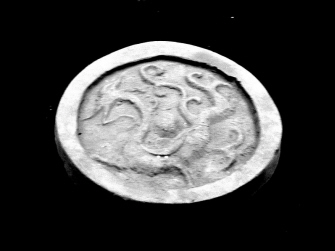 |
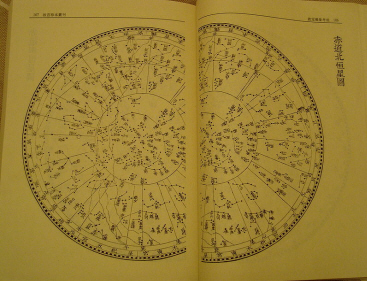 |
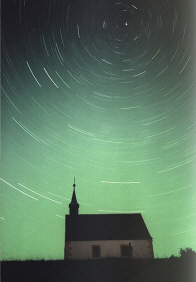 |
|
Quinglong-Azure dragon of
the East. Source Wikimedia Commons. Licence GFDL/CC 3.0. |
Starchart of the northern celestial sphere.
Qing Dynasty. YiXiangKaoCheng.
Source Wikimedia Commons. PD image. |
Circumpolar star trails.
Source Wikimedia Commons. PD image. Photo by Udo Kügel. |
A dragon was also thought to devour the sun during an
eclipse and would send the population running about banging things to frighten
of the dragon – which without fail appeared to work. The work of Petrus Apainus
contains examples of images of the dragon being used in a European astronomical
manuscript in the discussion of eclipses, not so long after the first official
European China contact in 1517 by the Portuguese. The Jesuit missionaries
followed in 1574 and their role in the exchange of knowledge including
astronomical was significant, but it seems from the images of Apianus that the
cultural significance of the dragon had already reached Europe.
|
A Chinese dragon on a
lower wall panel of the Moon Embracing Pavilion at Black Dragon
Pool, Lijiang, Yunnan. The Pavilion was originally constructed in
the Ming dynasty and has been rebuilt. Source Wikimedia Commons.
Copyright CC 3.0. Credit:© BrokenSphere / Wikimedia Commons. |
Cropped image.Petrus
Apianus ''Astronomicum Caesareum'' (1540). Source Wikimedia Commons.
PD image. |
The “dragon” on f80v does not look so much like the
long coiled Chinese dragon but more like a Western interpretation of the “cute”
dragon or a very early Chinese dragon such as the one below from the “Song”
dynasty (The dynasty of SN 1054). Note scales, crested head, thick tail and legs
structure.
|
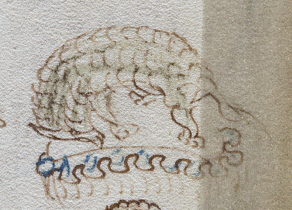 |
| f80v, cropped
mirror image. Voynich Manuscript. Credit:Beinecke Rare Book and
Manuscript Library, Yale University. |
Link to an example of a Song dynasty dragon sculpture in silver, displayed
in the Musee Guimet, Paris. If the sculpture was curled up it would be
similar in appearance to the image on f80v above:
Sung Dynasty dragon in silver with gold and turquoise
inlays (Musee Guimet, Paris)
The dragon has a number of possible meanings,
solar, northern, pole, indicating the central layout of the circular
Chinese astronomical maps, and it is near the area of SN 1572.
f82r
|
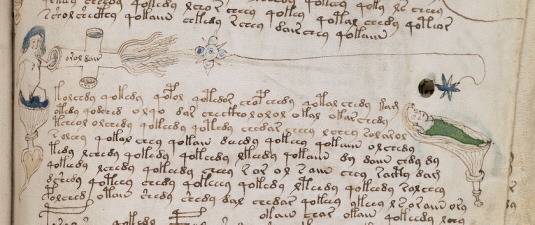 |
| f82r,
cropped, middle. Voynich Manuscript. Credit:Beinecke Rare Book
and Manuscript Library, Yale University. |
I suggest this shows the life cycle of a supernova. Born on the left
and shown large, indicating brightness, and with rays emanating from
it which was a common observation of supernova. On the right shown
much smaller and finally disappearing into nothing possibly indicated by
the conveniently placed hole (natural or added?) with the dead nymph
shown below to indicate this is what is happening. The nymph is
likely to be dead rather than sleeping as she appears to be wrapped
in a shroud. If the shrouded nymph is not a celestial body it
may depict death/disease caused on earth as a result of the star.
The label on the tubular object may be translated as "Labores Maius".
As shown above the bottom image on the folio has solar
imagery, possibly and eclipse and supernova, and also an astronomers ring.
The nymph holding the astronomers ring which measures the latitude of celestial
objects has a distinctive headdress of 11 sections.
|
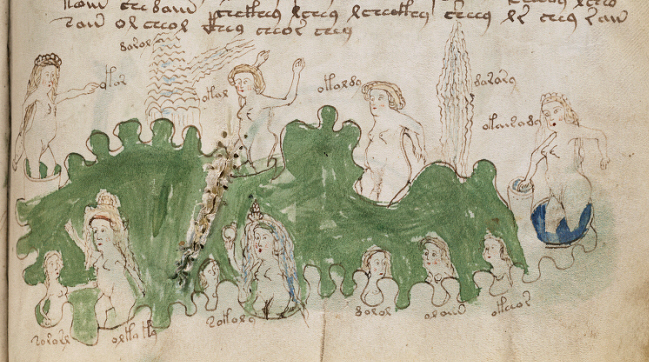 |
| f82r,
cropped, bottom. Voynich Manuscript. Credit:Beinecke Rare Book
and Manuscript Library, Yale University. |
The nymph on the far left holding the rattle like
(astronomical?) instrument appears to be an identical nymph to the one on f80v
except the instrument is held in the other hand. It may indicate
instrument used top measure longitude and latitude of one of the celestial
coordinate systems.
|
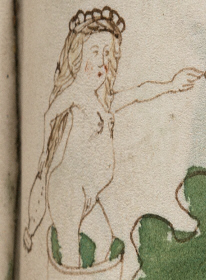 |
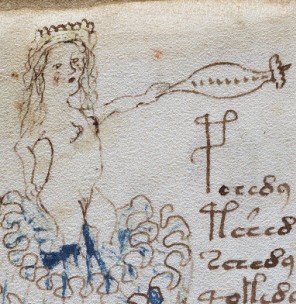 |
| f82r, cropped,
bottom. Voynich Manuscript. Credit: Beinecke Rare Book
and Manuscript Library, Yale University. |
f80v, cropped,
bottom. Voynich Manuscript. Credit: Beinecke Rare Book
and Manuscript Library, Yale University. |
As shown
f82v
This may show the four elements combined in various
celestial bodies, in particular the nymph at the top, middle may show the
generation of SN 1572 by Cassiopeia near to the Celestial Zero Meridian.
|
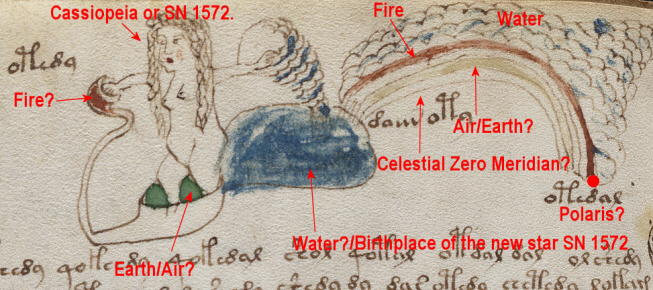 |
| f82v,
cropped. Voynich Manuscript. Credit:Beinecke Rare Book
and Manuscript Library, Yale University. Overlay by P.
Han showing possible explanation of elements on the
image in realtion to the "generation" of SN 1572 by
Cassiopeia. |
f83r
One of the nymphs on f83r has a very similar
appearance to what I described as a comet on f67v. The point coming off
the head indicating the tail of a comet. The star above the nymph also
appears to have a tail and the nymph at the top of the folio may be
"spraying stars" (a meteorite shower) from the end of the tube she
holds, and so this folio may deal with the subject of comets and
meteorites. The Chinese like many cultures associated comets with
misfortune and as far back as 1500 B.C. the astronomer Li Ch'un Feng
said that comets depending on their location may cause war and
conspiracy to overthrow the emperor, or cause the Emperor to die.
Halley's comet visit in 1066 was soon after SN 1054 and during the reign
of Emperor Yingzong who succeeded Renzong, Yingzong died the
year after the comet and would probably have been aware of SN 1054
during the reign of Renzong. However, Halley's comet was not
connected with previous historical sightings of comets until
Edmond Halley in 1682 noted the similarity of path of this comet with
the paths of the comets of 1531 (as recorded by Appian) and 1607 (as
recorded by Kepler), making the comets return approximately 75 years
apart. Although his ideas were not published until 1704 his ideas
were well formulated by 1695 when he calculated the orbits of many
comets based on Newton's laws of cometary motion and also noted bright
comets had appeared in1456, 1378, and 1301. Giotto do Bondone also
depicted a comet like star in his painting of the "Adoration of the
Magi" in 1305, possibly influenced by a passing of Halley's comet in
1301.
The year 1695 may be within the timeframe of
other conclusions I have made about modern constellations in the
manuscript and the nymph with the tailed star above her head may be a
direct reference to Halley's comet as seen by Kepler and Halley,
otherwise it may be the great comet of 1577 as seen
by Tycho. The 17th century witnessed a large number of comets and
they were still seen as portends of doom and even signs of the end of
the world by many still. The central image below located in the
astronomical section which I have allocated to the year 1054 and that
general era may also show Halley's comet in 1066, the comet Machholz
possibly seen in the year 1054 or one prior to 1054.
|
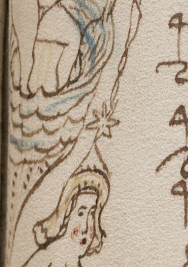 |
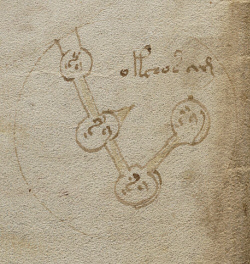 |
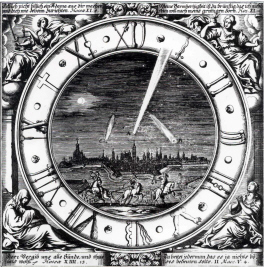 |
|
f83r, cropped. Voynich Manuscript. Credit:Beinecke Rare Book and
Manuscript Library, Yale University. |
f67v, cropped. Voynich Manuscript. Credit:Beinecke Rare Book and
Manuscript Library, Yale University. |
The
illustration shows a view of Augsburg, Germany with the comets
of 1680, 1682, and 1683 in the sky. Image credit: NASA/JPL |
"Eight things there be a comet brings,
When on high it doth horrid range:
Wind, famine, plague, and death to kings;
War, earthquakes, floods,
And direful change."
-Anon old poem
f84r
I suggest this scene shows a
supernova and that a title nearby says “stella nova”. The nymph on the
far left is specifically shown holding an orb in the same way as the
male figure on f57v which I suggested was SN 1054.
|
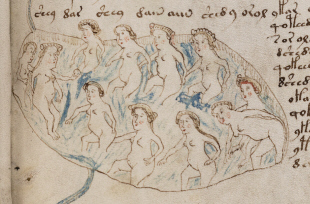 |
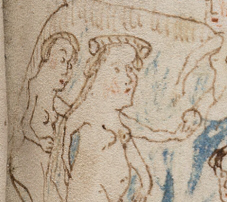 |
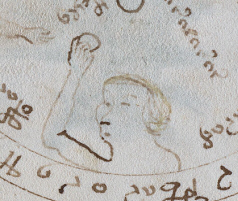 |
|
f84r, cropped. Voynich Manuscript. Credit:Beinecke Rare Book and Manuscript
Library, Yale University. |
f84r, cropped.
Voynich Manuscript. Credit:Beinecke Rare Book and Manuscript
Library, Yale University. |
f57v, cropped.
Voynich Manuscript. Credit:Beinecke Rare Book and Manuscript
Library, Yale University. |
Other subject matter may include conjunctions or
Binary/multiple Stars which were discovered after the invention of the
telescope. In 1650 Giovanni Battista Riccioli found Mizar to be a binary,
in 1656 Christiaan Huygens found that that Theta Orionis was three stars, in
1664 Robert Hooke found Gamma Arietis was also a triple star system, and in 1685
Father Fontenay observed that the star Acrux was really a binary pair.
|
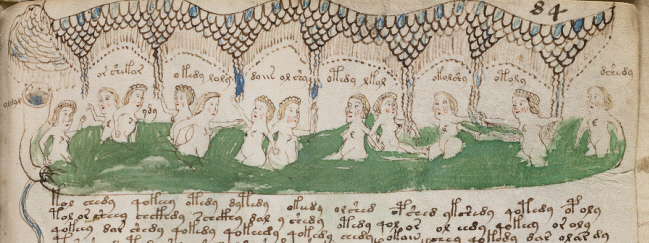 |
|
f84r, cropped. Voynich Manuscript. Credit:Beinecke Rare Book and Manuscript
Library, Yale University. |












































































